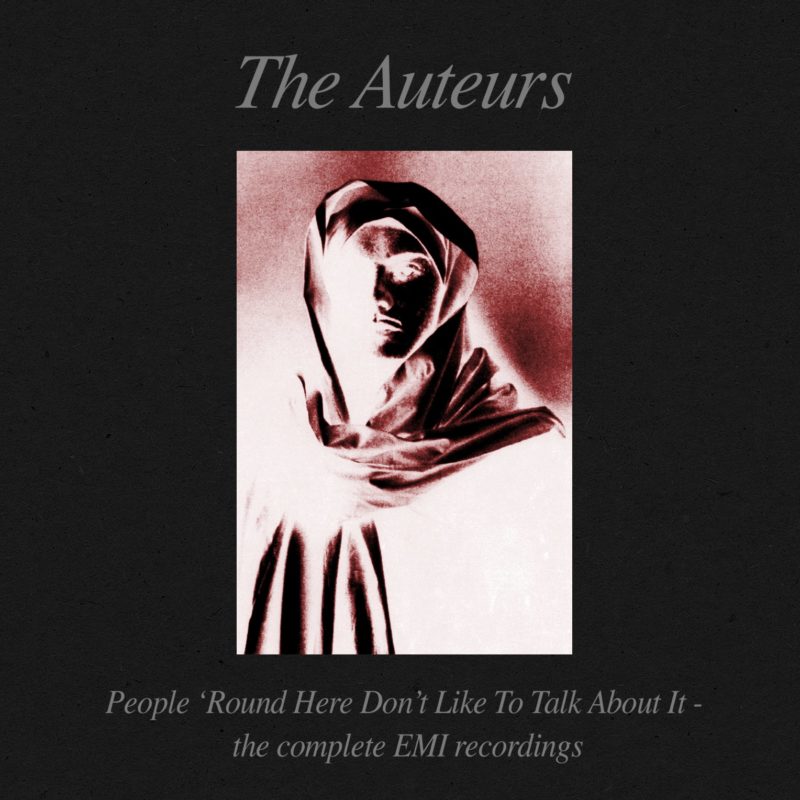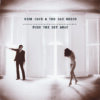Luke Haines has never been one to follow a conventional path to success. The frontman of The Auteurs, a band who seems to have found themselves in a sea of Britpop, although not really wishing to adhere to the conventions of the scene, something observed in his biography Bad Vibes: Britpop And My Part In Its Downfall. This musician, author, painter, and writer of the psychedelic cookbook – Outsider Food – Righteous Rock And Roll, as well as being a friend of former REM guitarist Peter Buck, during his career, has written lyrics that at times will leave you howling. He’s certainly no shrinking violet, as his words will testify. Listening to his back catalogue in preparation for this article, in ‘Bad Reputation (The Glitter Band)‘ he sings “…Gary Glitter, he’s a bad, bad man, ruining the reputation of the Glitter band…”, it’s his acerbic tongue that proves most amusing.
Haines served his apprenticeship with the band The Servants, who “recorded two commercially unsuccessful albums”. This might be true, but a rather harsh sentiment and it might be better put that they were a band who were before their time, or perhaps had employed the wrong vocalist. Their appearance on Creation Records’ C86 compilation earned them indie credentials, although in little over 6 years the band had called it a day. The path was now open for Haines to explore new horizons and this he did by gathering former Servants bassist and then-girlfriend Alice Readman, along with former classmate Glenn Collins to perform on drums. The 3 then created their delicious debut album New Wave. This is where we begin the journey through this artist’s music recorded for the EMI label. 4 albums from The Auteurs, along with Luke’s side project, Baader-Meinhof, not forgetting the compilation album, Das Capital.
Throughout this collection, the listener is able to devour material celebrating “one of the finest bands to emerge from and then evaporate in the hedonistic 1990s”. A band who were as quintessentially English, if for nothing more than Haines vocal furnishing, although I would suggest that there was more to this. The Auteurs were a band that saw the birth of Britpop, while missing its relative riches by a hair’s width. First to be served is 1993’s aforementioned New Wave, a release that features not just this Mercury nominated debut, but comes along with bonus material, from B-sides, to Rough Trade singles club versions and live/acoustic tellings which shed a whole new light on just how accomplished the band was. Oasis or The Auteurs, to my ears there was simply no comparison. This was an album that was hailed as a “…canny time capsule, bundled up with all the retro glam of the era…” and was cited in the 1001 Albums You Must Hear Before You Die list.
Only a year later saw the band release Now I’m A Cowboy. This was an album that didn’t quite achieve the same commercial success of its predecessor. Although it did feature a track that became one of their best-known songs, achieving “cult status” in ‘Lenny Valentino’. This was a number that from the outset displays a red-hot bpm and the original album featured in Mojo’s “Top 50 Eccentric Albums”. In this release, we see a version of the album, which in addition to its original content, includes a series of B-sides, alternate versions, as well as acoustic recordings of single ‘Chinese Bakery’ and album track ‘Modern History’. The first of these is a wonderfully stripped-back take on the original single, almost eerie in its setting, ‘Modern History’ picks up on this theme, although is some 2 minutes shorter than the album version and was first released as a one-sided Flexi-disc. Both of these numbers are certainly worth hearing.
2 years on and March 1996 saw the release of After Murder Park. With their commercial success still waning, this time Haines and co. observed what seems a far more band-led grasp on songwriting, employing a further half-a-dozen musicians, adding to the core band of Haines-Banbury-Readman-Rockford. From this listening, I’m definitely beginning to appreciate what I had missed on first hearing the album nearly 30 years ago. Okay, this album may not feature the stand-out singles that the earlier recordings did, but instead is a slow burner, seeping into all those cracks and crevices, until you find yourself swathed in the whole damn thing, and what a wonderful feeling it is. This version includes those original 12 tracks, along with another 10 described as B-sides and rarities. Of these tracks worth paying particular attention to might be, ‘Kenneth Anger’s Bad Dream’ in which one man’s bad day is laid bare, and hearing this I guarantee you will roll your eyes and sympathise with the protagonist. Cellist James Rockford stretches his instrument’s low tones, something you will be familiar with from New Wave. Another similar number is ‘Former Fan’ where the central character is one to which I’m sure many can relate. In conclusion, what an album, and at this point, my opinion is that The Auteurs are just getting better and better.
Disc four sees a change in direction, as Luke Haines embarks on one of his many side projects. Baader-Meinhof, named after the East German far-left terrorist group, is where Haines offers a document which goes some way to explaining the group’s motives. This is set to a huge musical stage, part 70s Blaxploitation soundtrack, part east-Indian pop and part minor classical score. Only 3 years on from New Wave and Haines had once again found the excitement in making music. The original album has been added to by mostly remixed versions, but also includes the track “I’ve Been A Fool For You“, a number to which I’m sure we can all relate, at sometime or another. It’s just like the original album, just better and those remixes are remarkable, real remixed versions in an 80s style, but with the benefit of Drum and Bass.
What comes across from the penultimate disc How I Learned To Love The Bootboys, is that it appears to be a homage to Haines’s childhood. It travels through life as it proceeds. Named after this Scandinavian Neo-Nazi movement, this displays Haines’s wry sense of humour. Kicking off with ‘The Rubettes’, 70s glam in tow, Haines sings “Hang up your jeans, put out your school clothes. Tune in for the top ten. Monday morning’s hours away. Say goodbye to the weekend. Slip between the sheets with my brand new friend…”. Here you can actually feel yourself in the place of the teenager in the story as he offers his narration, especially if you spent your adolescence as Haines did, growing up through the 70s. This is like walking through a time tunnel, in the shoes (or perhaps slippers) of the narrator, as you take in the sounds, and feel, of this virtual transistor radio. This is a brilliant start to what became The Auteurs’ final album and is a song that’s filled with more than a cereal box worth of edible vibes. What follows is ’1967’, the songwriter’s birth year, as he makes clear that “…In 1967, no pop in our record collection. The Beatles and Stones mean nothing to us. I think we should count our blessings in 1967…”, a dig at fellow songwriter Guy Chadwick maybe, born some 11 years earlier. So ‘The Beatles and The Stones’ really was this songwriter’s coming of age. What’s wonderful about the content here, is it travels through time and picking up the story, the narrator suggests “…Present time, I’ll apologise to the nation. We are bedazzled, we’re ordering cocktails. We act like peasants…”. This album was released at the end of the nineties, still drunk on Blair’s New Labour, at a time that had seen Thatcher’s economic project come crashing down. Life is once again resuming for the everyman, Pulp’s 1995 album Different Class has foretold this and here Luke Haines becomes the storyteller at the end of the decade. The lead track to this album, ‘How I Learned To Love The Bootboys’ sees the fuzz guitar heard earlier on the album, giving way to deep synthetic tones as Haines asks “…All right, oh yeah who’s scared tonight?. All right, oh yeah who’s scared to dance…” a contrast to the common perception of the boot boys, this time far more interested in the dance, than knuckledusters, flick knives, and right-wing doctrine. Musically the album is set out eloquently, proceeding like a roadmap through its original twelve tracks. These are in tone with what you would expect from an album by The Auteurs, but from a songwriter who had grown in maturity. Here the original 12 tracks have been expanded by a further 12 that were originally found on the imported version. Among these tracks, it features what is billed as 4 acoustic versions of earlier heard numbers and an alternate version of the title track, this time titled ‘Essex Bootboys’ . Some of these tracks could have been found on the compilation Luke Haines Is Dead, but have been assembled on this set to give a fully inclusive experience.
The final disc in this collection is the 2003 compilation, Das Capital. Featured are 18-tracks in this incarnation, some of which we have heard before, although this time coming as alternate versions, whilst others are as rare as the proverbial. It commences with one of Haines’s musical fights of fancy, the partial orchestral ‘Das Capital Overture’ where violin clashes with electric instrumentation, in this meeting of early Auteurs. Through alternate takes of ’Show Girl’, ’Lenny Valentino’ and ‘Junk Shop Clothes’ , tunes that have found themselves working their way into our musical psyche. This album culminates in six 4-track demos, which, unlike the earlier 12 numbers, are unique to this version of the album. Luke Haines, following his work with The Auteurs has always brought to mind another chameleon of musicians, Julian Cope, where their writing of music seems to be a need, just like eating or breathing. Having followed the artist’s career from his earliest work with The Auteurs, looking back at The Servants and on through Baader Meinhof and beyond, this has personally been a delicious menu and one where I haven’t felt bloated or uncomfortable. People Round Here Don’t Like To Talk About It is a worthwhile set of recordings, for indie-heads, musos and fans of the artist. Some of these are difficult to come across these days, so another public service has been offered.




